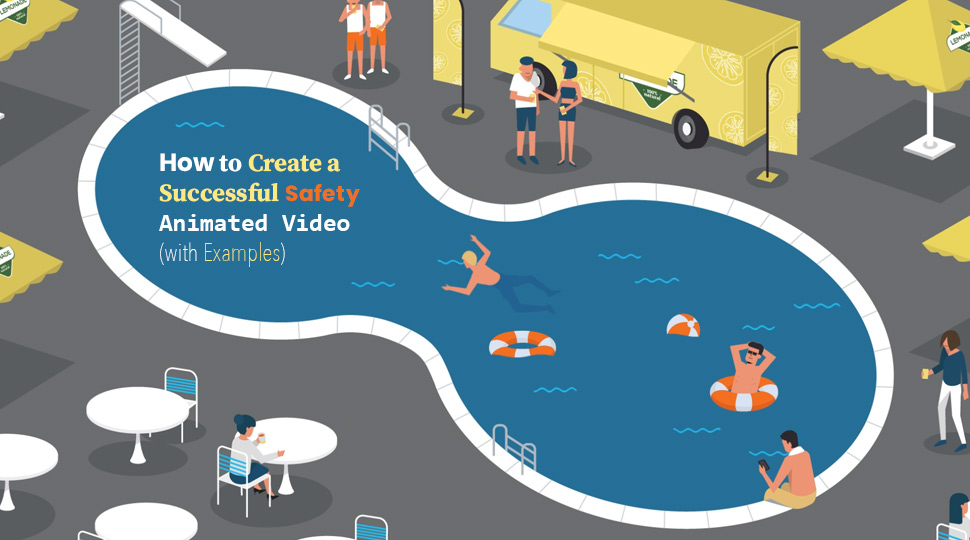Safety animated videos are an excellent way to get the message across and achieve the desired goal of a particular safety video. Creating such a video is not an easy process, though. It can take time, and you should be prepared to invest a significant sum.
These videos were common across industries that raise awareness of potential risks to health, online privacy, or those highlighting safety procedures in an emergency. They are getting more traction nowadays due to the COVID-19 pandemic.
The problem with these videos is that they need to hit the sweet spot. They have to capture the viewers’ attention, be engaging so that viewers sit through the end, and still be able to communicate the safety message. That’s what defines a successful safety animated video.

Artwork by Tomasz Wysocki
How do you achieve it? To help you create a successful safety animated video, we’ve put together a list of easy-to-follow-steps. Let’s get on with it, shall we?
Figure Out The Goal of The Video and Fact-Check The Information
The first thing you have to do is to figure out the goal of your video. It is imperative because the goal will shape your decisions down the road – writing a script, choosing the animation style, tone, and voice artist.
Not all safety animated videos have the same goals. If we had to put them into categories based on the goals they are set to achieve, it would look like this:
- Instructional videos
- Hazard demonstration videos
- Videos for raising awareness of potential hazards
- Training & educational videos
The best way to figure out the goal is to take several things into account – your products/services, the environmental factors, and your target audience needs. The perfect example is the video created for Facebook “Photo Safety.”
Facebook users upload and share millions of photos every day. The video sends a strong message that Facebook cares about its users’ safety and informs them how to manage photos and report potential abuse.
This type of video already has a common goal, as it is all about safety. However, you can set any of the sub-goals from the list above or combine any of them. For instance, you can create a hazard demonstration video with instructions.
There is one more thing to do before you can go creative. You should fact-check the information. We are talking about the well-being of people and providing them with actionable information. The information has to be 100% accurate.
While doing your research, make sure to use the information published by trusted sources and double-check the information before using it in the script.
Write a Script That is Not Boring While Covering The Safety Steps
Safety procedures are, by nature, boring, especially to customers and clients who are about to watch a safety video for the hundredth time. On the other hand, safety procedures are fundamental. In many instances, they can save people’s lives. So, how do you make someone watch something as dull as a video that outlines safety steps?
Fortunately, a safety animated video can help you create engaging content; something people would want to see. To do it, you need to step into the shoes of an entertainer and write a killer script. When we put a killer script, safety tips, and animated video in one sentence, there is one video that comes above the fold – The Virgin Atlantic Safety Film.
People behind it did a marvelous job turning safety steps into something everyone would like to watch. The video creators leverage movie-like storytelling to capture the viewers’ attention.
The hero of the story starts out like you, a regular airplane passenger with no interest whatsoever to actively listen to safety instructions. Soon, he drifts off into a nap finding himself in different, potentially harmful situations and engagingly showcasing the safety procedures.
If anything, this example tells us that a well-written and engaging script is the cornerstone of a successful safety animated video. You can start by outlining all the safety steps and procedures you want to cover in the video.
Then, have a brainstorming session with your team to come up with exciting ideas for the script. As you could see from the example, incorporating safety steps in a story backed up with the right tone is a win-win scenario.
Choose an Interesting Animation Style
Once you’ve set the goal and have the script in your hands, you need to choose an animation style. It may appear challenging for you to pick the right one with dozens of options to choose from. The right animation style for a safety animated video can help you achieve your goal, bring your script to life, and make it interesting at the same time.
It significantly narrows down your options as you can’t use, let’s say, paint-on-glass or sand animation. So, what are the viable animation styles you can go for? 2D animation, 3D animation, and whiteboard animation are all excellent options. Once again, your creativity is the only limit here. Here is a great example of what we mean by that – Cathay Pacific Airline Safety Video.
The company decided to create an interesting animation style. To do it, they’ve combined live-action shots with animated graphics. The blend of live-action video and animated characters delivers an unexpected moment and invites the viewers to see what the animated character does in a real-world scenario.
The animation style can make or break your safety animation video. This is why you should consult with the video agency you choose. Check what they think about your ideas and ask them to share their vision with you. Take a look at what the competition is doing and how the audience reacted to their videos. There is a lot to learn from other brands’ successful and less-successful animated videos.
Inject Humor in The Storyboard – Allow The Video Agency To Be Creative
The first association when you hear a word video is entertainment. When watching a video, people want to be entertained. Unfortunately, a safety animation video is all about lecturing people. The best way to hook your audience and deliver your “lecture in safety” is to use humor. The best teachers know it, and they use it to keep the classroom quiet and engaged.

Artwork by Sherif Fouda
In a classic video format, portraying humor is only possible with real actors. In animation, you can achieve it in a variety of ways. Adding animated elements, music, and simply modifying animated characters’ facial expressions will deliver humor in a fun and cheerful way, even when outlining safety tips. Take Godrej Safety Tips – Elderly Parents animation as a great example.
The video showcases a few easy-to-implement safety tips for adults who have elderly parents taking care of themselves. While the video’s subject is extremely serious, the creators did an excellent job of making the video cheerful. The characters’ body language, facial expressions, music, and the burglar fleeing the scene at the end of the video make this animation fun and engaging to watch.
Injecting humor in the storyboard takes some experience and creativity. Consider allowing the video agency to be creative. Stay in the loop to see how they plan to make your safety animated video cheerful. It will enable you to provide some insider information about your company or your target audience that the video agency can leverage to create something funny.
Find a Suitable Voiceover Artist
There is nothing wrong with using only text for your safety animated video. The previous example showcases it. However, if you want to add a human touch and additional elements to capture viewers’ attention, a voiceover is the way to go.
You will need a voiceover artist to do it. How do you find the right one for your animated video? Any voice has the following characteristics:
- Pitch – the perceived highness or lowness of a voice;
- Speech rate – how slowly or quickly the voice speaks;
- Tone & texture – unique sound patterns of a voice;
- Intonation – defines the way for the words to be delivered;
The right voice is the one that reflects your primary and secondary goals. Here are two great examples to help you understand.
The “How to Avoid Covid-19?” awareness animated video features a female voiceover artist as the narrator. It delivers safety tips calmly and reassuringly, using intonation to bring the most important ways to avoid the COVID-19 virus into focus.
This calm voice was chosen for a particular reason. People are in a state of panic, so there is no need to add to that anxiety. Plus, at the ending of the video, you can see a glimmer of hope, saying that we will “crush this virus together.”
On the other hand, Panasonic’s Ceiling Fan (Safety Awareness) Animated Video aims to raise the safety awareness of hazards when installing and using a ceiling fan. The friendly narrator is present on the screen. And since it is a robot, it features a friendly male voice with a tone and texture that perfectly suit a talking bot.
Most prominent video agencies work hand-in-hand with voiceover artists to help you get the best one for your animated video. You can ask the voice-over artists to read part of your script so that you can audition them and choose the best voice that matches your video theme.
As you can gather, there is no one-size-fits-all animated video solution. There are a lot of factors at play, given that every business and target audience is unique.
If you want to streamline this process and create a successful safety animated video, contact our team, and get a quote today! We will help you with a free consultation about your upcoming safety video, as well.


